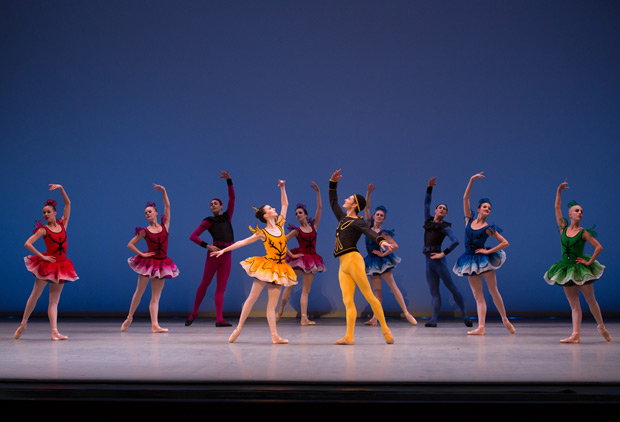
© Rosalie O’Connor. (Click image for larger version)
The Suzanne Farrell Ballet
Program A: Danses Concertantes, Intermezzo from Brahms-Schoenberg Quartet, Valse-Fantaisie, Slaughter on Tenth Avenue
Washington, Eisenhower Theater
11 November 2012
Suzanne Farrell Ballet website
Suzanne Farrell interview (November 2012)
For the past decade, The Suzanne Farrell Ballet has kept George Balanchine’s flame alive. Each performance of the company is a celebration of the great ballet master, whose vast heritage, as it is becoming more obvious with time, is not only ballet’s past but also its future.
Suzanne Farrell represented Balanchine’s epitome of the ideal dancer – “his largest single creative investment.” She, in return, completely devoted herself to his artistry and interpretation of his works. Her knowledge and appreciation of his technique, aesthetic and philosophy as well as his repertoire are unparalleled. As artistic director of her own company, Farrell works tirelessly to preserve and promote the legacy of her mentor. Each season the Farrell Ballet unfailingly offers unique insights into the universe of Balanchine ballets.
Farrell’s company is a small pickup group with hardly any stars even among the principals. More than a third of this season’s company roster consists of newcomers: 10 out of 27 dancers joined the troupe this year; and many of them have never had any previous training in the Balanchine technique. The company is a part-time enterprise with a very brief rehearsal period. Farrell herself admits that she works with some of her dancers for only three weeks. “It’s a very short time to make it look like a group of united individuals,” she says. Yet despite these limitations the Farrell Ballet over the years has never failed to make a place in their audience’s hearts. When watching them perform one understands what dance critic Joan Acocella meant when she said: “Every single time Suzanne Farrell sets a Balanchine ballet – it rises from the dead.”
This season the company brought to the stage of the KennedyCenter’s Eisenhower Theater two all-Balanchine programs. The first featured three company premieres: Danses Concertantes, Intermezzo from Brahms-Schoenberg Quartet, and Valse-Fantaisie. The second program included Divertimento No. 15 and the company premiere of Prodigal Son. Both programs were capped by a Broadway romp, Slaughter on Tenth Avenue. Each dance reflected a unique side of Balanchine’s mastery; together they showcased the remarkable range of his creative genius.
“A glittering little piece, brilliantly animated and brilliantly civilized,” wrote Edwin Denby about the original 1944 version of Stravinsky’s Danses Concertantes – the first original work of Balanchine for the Ballet Russe de Monte Carlo. (He served as resident choreographer for the troupe at the time.) In 1972 Balanchine returned to the Stravinsky score and completely re-imagined the ballet for the NYCB’s Stravinsky Festival. Farrell revived this latest version of Danses Concertantes for her company’s season as part of the Balanchine Preservation Initiative.
Effervescent and humorous, Danses Concertantes is a charming showpiece for 14 dancers (a principal couple and four trios of two women and a man), featuring a series of pas de trois, solo variations and a duet for the leads. It opens and closes with a march for the entire ensemble: the supporting cast make their entrances and exits by threes in front of the “marquee” curtain, followed by the soloists. The ballet’s ever-changing movement patterns superbly mirror the jazzy and syncopated Stravinsky score.
Farrell poured her heart into the restoration of this “lost” Balanchine gem. In her radiant staging, the ballet’s lively atmosphere of Italian commedia dell’arte vividly came to the fore. Close attention was paid to every little detail of the stage décor. A stunning drop curtain – “the first thrill” of the original version – was specifically made for the new production, as were the spectacular costumes.
At the Sunday matinee performance Elisabeth Holowchuk and Kirk Henning danced admirably in the leading roles. Showing his penchant for comedy Henning truly relished his part and was especially effective in the vivacious and witty solo flecked with jester-like movements. The rest of the cast was animated, if not always technically polished.
More than anything Balanchine’s Brahms-Schoenberg Quartet (1966) is about music and dancing. Still, you can’t help but look for a story here, for Farrell’s elegant staging of Intermezzo brought into focus an inescapable sense of romance. The principal dancers, Heather Ogden and Michael Cook, responded keenly to the effortless sweep of the music, the second movement of Brahms’s Piano Quartet No. 1 in G Minor orchestrated by Arnold Schoenberg. Their impassioned pas de deux, with its gentle embraces and arching swoons, was the heart of the ballet. The dancers seemed to be rarely apart, caught in a constant flow of complex partnering.Ogden proved herself a formidable technician and dazzling performer. A trio of supporting ballerinas, however, wasn’t quite as consistent.
The romantic ardor of Brahms’ Intermezzo was reintroduced in Mikhail Glinka’s Valse-Fantaisie in B Minor. In 1856, the Russian composer orchestrated his piano piece, waltz-scherzo, which he originally wrote in 1839. The music has eloquently been called “an incomparablePetersburg musical poem of love, longing, and suffering.” This amazing waltz, with its slowly unfolding romantic drama, quite literally caused a sensation inSt. Petersburg and ultimately became a source of everlasting inspiration for Tchaikovsky and Glazunov.
Balanchine had a special affinity for Glinka’s waltz – he choreographed to it at least three times, in 1931, 1953 and 1967. His final version of Valse-Fantaisie was part of Glinkiana, an evening-long ballet in four movements, and it happened to be its most enduring section. Made for a central couple and a quartet of ballerinas, the ballet is a luminous evocation of the 19th century Romanticism.
The performance of Valse-Fantaisie turned out to be a real marvel. Dressed in gorgeous emerald costumes, the dancers responded to the music and space with terrific sweep and spontaneity. This was a truly incandescent waltz, charged with both energy and glamour. The charismatic Violeta Angelova was light, piquant and assured in her role full of graceful, elegant leaps and turns. Her partner, tall and lissome Pavel Gurevich, danced with admirable poise. The Opera House orchestra led by Leif Bjaland played with compelling emotional power, giving Glinka his full measure of glory.
Slaughter on Tenth Avenue, a self-contained dance number from the Broadway musical On Your Toes (1936), may seem like a lightweight piece. Yet it shows a side of Balanchine that Farrell so aptly summarized in her autobiography Holding on to the Air. “Balanchine had time for everything, including pure fun,” she wrote. “He never underestimated the value of sheer entertainment – or an audience’s hunger for it.”
Slaughter has always been a perfect showcase for the Farrell troupe, and the company danced it to the hilt on Sunday. Michael Cook was impressive as the Hoofer, showing off his virtuosic tapping skills with genuine comic flair. In the Farrell role as the Striptease Girl, Natalia Magnicabally exuded both sexiness and sophistication, bringing to her part a touch of enigmatic chic. From the ballet’s first moment there was plenty of infectious dancing as well as genuine fun. The entire cast, from the Ladies and Gentlemen of the Ballet to the Gangster to the Big Boss, plunged into this boisterous comedy with utter conviction and joy, dancing ravenously and bringing the whole program to a rousing finale.









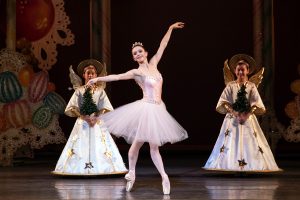
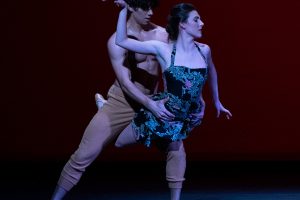
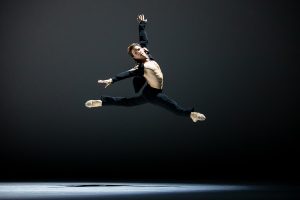


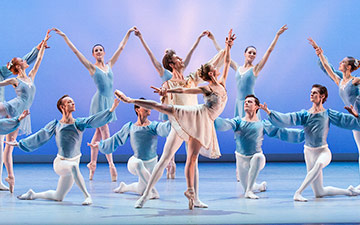
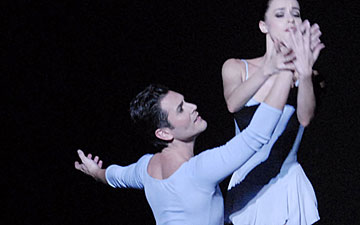

You must be logged in to post a comment.